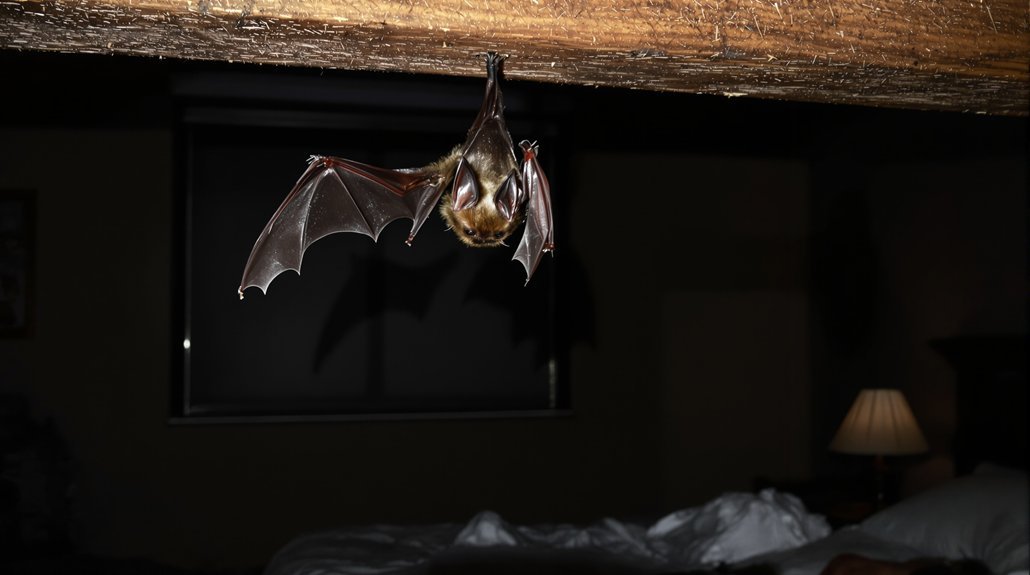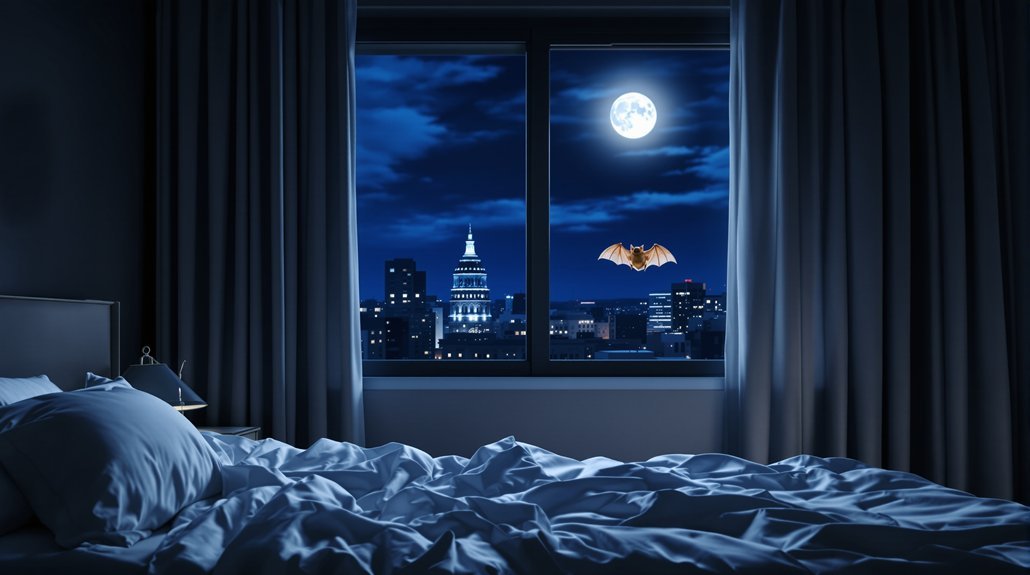Bats can bite people, but the chances of being bitten in your sleep in Des Moines are very low. Bats are mostly nocturnal and prefer to avoid humans. They typically find homes in dark, secluded spots, but they do not seek out people. If you encounter a bat indoors, it is important to stay calm and allow it to leave on its own. There are effective ways to prevent more interactions with bats, which are worth considering.
Key Article Highlights
- Bats are generally shy and avoid human contact, reducing the likelihood of a bite while sleeping.
- They are nocturnal and are more active at night, but typically do not seek out humans.
- Bats can enter homes through small openings; sealing these can prevent indoor encounters.
- If a bat is found indoors, remain calm and let it exit on its own.
- Rabies is a concern if bitten; seek medical attention immediately if bitten by a bat.
Understanding Bat Behavior

Although bats are often misunderstood, their behavior is essential to understanding how they interact with humans. Bats are primarily nocturnal creatures, active during the night when they hunt for food. Their diet mainly consists of insects, which they locate using bat echolocation. This unique ability allows bats to emit sounds and listen for the echoes that bounce back, helping them navigate and find prey in the dark. Bats play a critical role in controlling insect populations, benefiting agriculture and human health. Understanding these behaviors helps dispel myths and highlights the importance of bats in the ecosystem. Recognizing their nocturnal activity and echolocation skills can foster a greater appreciation for these creatures and their role in our world. Additionally, their behavior patterns include roosting in attics or tree cavities, which can sometimes lead to unintentional human encounters.
Common Myths About Bats

Many people hold misconceptions about bats that can lead to fear and misunderstanding. One common myth is that bats are blind. In fact, bats have excellent vision and use bat echolocation to navigate and find food in the dark. Another myth is that all bats are harmful. Most bats eat insects and help control pests. Their nocturnal habits mean they are active at night, reducing their contact with humans. Some also believe bats will attack people. However, bats are generally shy and avoid humans. Understanding these facts can help dispel fear and promote appreciation for these unique creatures. Recognizing their ecological role is crucial, as they are important for damage management and controlling insect populations. By understanding these aspects, people can learn to coexist peacefully with bats in their environment.
Likelihood of Encountering Bats in Your Home

Understanding where bats like to live can help people know their chances of finding them in their homes. Bats often enter through small openings and may be more active during certain seasons. Knowing these habits can help residents take steps to prevent encounters.
Common Bat Habitats
Bats often seek shelter in places that provide warmth and protection, making homes an attractive option. These creatures are known for their ability to navigate using bat echolocation, allowing them to find roosting sites easily. Common habitats include attics, basements, and wall voids. Bats prefer spaces that are dark and secluded, where they can rest undisturbed during the day. They often enter buildings through small openings, seeking safe spots to roost. The presence of bats in a home can increase the likelihood of encountering them, especially in urban areas like Des Moines. Understanding these common bat habitats is important for homeowners, as it can help them take steps to avoid unwanted visits from these nocturnal animals.
Entry Points Explained
A variety of entry points can allow bats to access homes in urban areas like Des Moines. Small gaps in roofs, vents, and cracks in walls are common openings. Bats use their keen bat sonar to navigate and find these entry points, especially at night due to their nocturnal habits. They can easily slip through spaces as small as a quarter. Once inside, they may roost in attics or basements, leading to potential encounters with residents. Homeowners should regularly check for these entry points and seal them to reduce the risk of bats entering. Understanding how bats access homes can help individuals take preventive measures against unwanted visits during the night.
Seasonal Activity Patterns
The likelihood of encountering bats in homes varies with the seasons. In spring and summer, bat activity increases as they search for food and breeding sites. This is the peak time for bat migration, making homes more likely places for encounters. Bats often roost in attics, eaves, and other sheltered areas. In fall, bats prepare for winter, becoming more active as they seek warm locations. During winter, bat activity decreases profoundly. Many bats hibernate or leave for warmer climates. Homeowners should be aware of these seasonal patterns to reduce the chances of encountering bats. Proper sealing of entry points and monitoring for signs of bats can help maintain a bat-free home, especially during peak seasonal bat activity periods.
What to Do If You Find a Bat Indoors
What should one do when discovering a bat indoors? It is important to stay calm and avoid panic. First, one should close all windows and doors to contain the bat. Next, one can turn off lights and leave the room. Bats are nocturnal and prefer darkness. They may communicate through sounds, so keeping quiet is essential. If the bat does not leave on its own, contact a professional for assistance. It is also important to remember that bats play a role in the ecosystem, including controlling insect populations through their diet.
| Step | Action |
|---|---|
| 1 | Close all windows and doors |
| 2 | Turn off lights |
| 3 | Leave the room |
| 4 | Keep quiet |
| 5 | Call a professional |
Preventing Bat Encounters
Preventing bat encounters requires taking specific precautions around homes and properties. Homeowners should seal any gaps or holes in walls, roofs, and eaves. These openings can allow bats to enter. Installing screens on windows and vents can further keep bats outside. Reducing outdoor lighting can also help, as bright lights attract insects, which in turn attract bats. Understanding bat acoustics can aid in identifying their presence. If bats are a known issue, consider getting a rabies vaccination for added safety. Keeping food sealed and cleaning up debris can deter them as well. Regular inspections of property can help catch potential problems early, ensuring a safe environment free from unwanted bat encounters.
Health Risks Associated With Bat Bites
Bats can pose health risks, especially if they bite. One major concern is rabies transmission. Rabies is a serious viral infection that affects the brain. If a person is bitten by a bat, they may be at risk of contracting this disease.
Infection symptoms can vary. Common symptoms include fever, headache, and confusion. In severe cases, rabies can lead to paralysis or death.
| Health Risk | Rabies Transmission | Infection Symptoms |
|---|---|---|
| Bat bites | Yes | Fever, headache |
| Serious illness | High | Confusion, weakness |
| Fatal outcomes | Possible | Paralysis, coma |
Awareness of these risks is important for safety and health. Seek medical advice if bitten.

